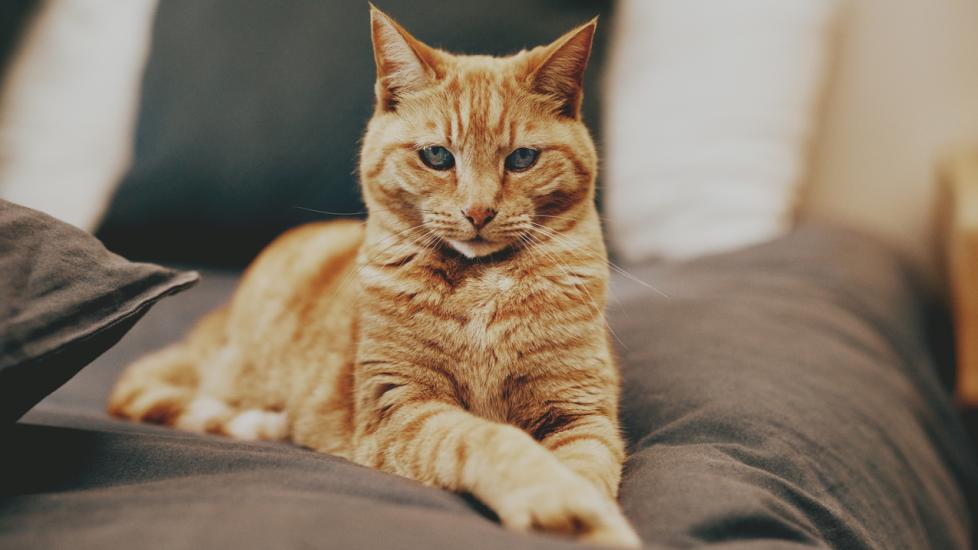Feline Hyperesthesia Syndrome (Twitchy Cat Syndrome)
What Is Feline Hyperesthesia Syndrome?
Feline hyperesthesia syndrome (FHS) is also called rolling skin disease and twitchy cat syndrome, which should give you an idea of what signs to look out for in your cat. FHS generally involves muscle contractions that your cat cannot control, along with changes in behavior.
FHS remains poorly understood and may have neurological, psychological, or dermatological (skin) causes. A variety of other conditions that can look very similar must be ruled out before feline hyperesthesia syndrome is diagnosed.
Health Tools
Not sure whether to see a vet?
Symptoms of Feline Hyperesthesia Syndrome
A cat with feline hyperesthesia syndrome typically has intermittent bursts or episodes of signs lasting 20–30 seconds. During these episodes, you may observe any of the following symptoms:
-
Rippling or twitching of skin on the lower back (both after touch and for no apparent reason)
-
Dilated pupils
-
Brief bursts of jumping and running, as if startled
-
Excessive meowing and other noises
-
Tail-chasing
-
Biting or licking the lower back, sides, hind paws, rear, or tail
-
Pain or discomfort when petted or touched
-
Tiredness
If you touch your cat during an FHS episode, you could make the signs worse, and your cat might become aggressive. Your cat will not have control over this.
If you notice your cat’s back twitching or any of the other signs listed above, it’s best to stay calm and try not to handle your cat during an episode, even though the signs can be severe and even frightening.
Causes of Feline Hyperesthesia Syndrome
Nobody knows what causes feline hyperesthesia syndrome. Because different cats with hyperesthesia respond to different types of treatment, there may be multiple underlying causes. In some cats, feline hyperesthesia syndrome is diagnosed along with another underlying condition.
Causes of feline hyperesthesia syndrome are usually considered dermatological (skin problems), neurological (problems with the nervous system), or psychological (mental health problems). Each of these may have different triggers for FHS episodes.
Dermatological Causes of FHS
-
Allergies
-
Immune-system-related disease
Neurological Causes of FHS
-
Neuropathic (nerve) pain
Psychological Causes of FHS
-
Displacement behavior
-
Compulsive behavior
-
Attention-seeking behavior
Food hypersensitivity may also contribute to FHS. In recent research, one cat with hyperesthesia had symptoms disappear after trying a hydrolyzed protein diet.
Cat Breeds Prone to Feline Hyperesthesia Syndrome
Feline hyperesthesia syndrome can happen in any cat, though it may be found more frequently in Abyssinian, Burmese, Persian, and Siamese cats.
FHS is also more common among younger cats. In two studies, the average age when feline hyperesthesia syndrome symptoms were first noticed was around the first year of the cat’s life, and most cats with the condition were under 7 years old.
How Vets Diagnose Feline Hyperesthesia Syndrome
If your cat is showing mild to moderate signs of feline hyperesthesia syndrome, contact your vet within 24 hours. If a severe episode occurs and lasts longer than two to three minutes, take your cat to an emergency vet as soon as possible.
Your vet may perform the following tests:
-
A dermatological (skin) workup to identify possible flea allergies, even if your cat does not go outdoors.
-
An evaluation for pain or a neurological condition.
-
Medication trials may be part of the workup process. When cats are under stress, they can be very good at hiding signs of pain or discomfort. Evaluating their response to a medication targeting pain or itchiness, for example, can provide valuable information.
Feline Hyperesthesia Syndrome Treatment
Once other conditions have been ruled out and feline hyperesthesia is diagnosed, your veterinarian may need to consult with or refer you to a veterinary behaviorist for a full treatment plan. Your treatment plan may include:
-
Changes to the environment
-
Medication or supplements
-
Behavior modification
The purpose of treatment is to make changes that help reduce the number of episodes. Behavior modification will give your cat a different emotional response or behavior to perform during times of stress.
Recovery and Management of Feline Hyperesthesia Syndrome
In one study, six out of seven cats showed significant improvement with medication, and five cats had resolution with just one medication. For some cats with hyperesthesia, the episodes may come back after several months. For others, the relief lasts much longer.
Feline Hyperesthesia Syndrome FAQs
Why is my cat twitching?
Twitching in cats can be caused by many possible medical conditions ranging from mild to serious, including seizures, toxin ingestion, infections, pain, feline hyperesthesia syndrome, and more. If your pet has developed new twitching, it’s best to try to record the episode on video and contact your veterinarian immediately.
If the episode lasts more than a few minutes or reoccurs more than twice in a 24-hour period, this should be treated like a medical emergency. Take your pet to the closest emergency veterinary hospital immediately.
Can a cat survive feline hyperesthesia syndrome?
Yes, though treatment is often necessary to ensure a good quality of life.
Is feline hyperesthesia syndrome genetic?
There is no evidence of a genetic link in feline hyperesthesia syndrome at this time.
At what age does feline hyperesthesia syndrome happen?
It is most common in young cats, under 7 years old. Symptoms typically begin appearing in cats at 1 year of age.
Why does feline hyperesthesia syndrome happen?
While it has been associated with skin conditions, pain disorders, neurological problems, and psychological disorders, the underlying reason is largely unknown.
How do I help my cat with feline hyperesthesia syndrome?
See your vet for a thorough workup of potential causes. Your vet may consult with a veterinary behaviorist to create the best plan for your cat.
Featured Image: iStock.com/Delmaine Donson
References
Help us make PetMD better
Was this article helpful?
